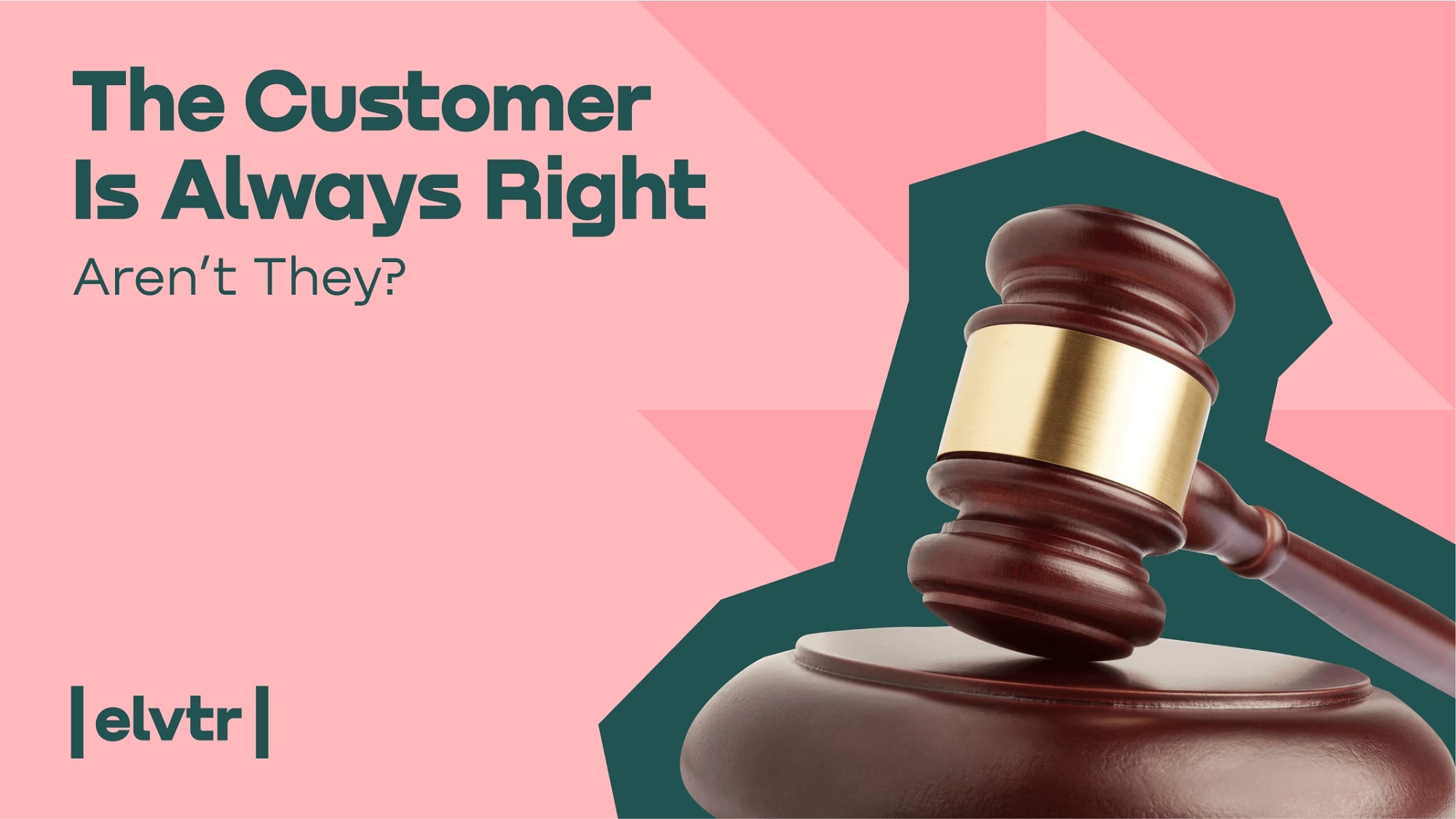- MAIN PAGE
- – elvtr magazine – THE CUSTOMER IS ALWAYS RIGHT, AREN’T THEY?
THE CUSTOMER IS ALWAYS RIGHT, AREN’T THEY?

In 1893, Marshall Field opened Marshall Field's, Chicago's first department store. The entrepreneur believed that business success directly depended on customer’s happiness. That’s why he ordered salespeople to remember the names and preferences of their customers. No matter how difficult a visitor was, Field urged his employees to remember that the customer is always right. Henry Selfridge, who opened the first department store in London with the same service concept, followed Field's example.
Later, the Swiss César Ritz introduced the ideology of Le client n'a jamais tort (French for "The customer is never wrong") to the hotel business when founding the Ritz Hotel in Paris.
Field, Selfridge, and Ritz taught their employees: if a visitor is dissatisfied with something, there are valid reasons for it that need to be promptly addressed. No one could even question the validity of the claims. However, the "The customer is always right" ideology is no longer relevant. If taken too literally, it can even be detrimental to business.
Let’s figure out how a sales manager should deal with dissatisfied customers.
Is the customer always right?
In short, he is not. Sometimes customers make mistakes. Thus, employees have to know how to act in such situations. It would be a bad decision to take the blame for a blunder for which the business is not responsible. Let us examine the examples.
1. Distrust within the team = poor company culture
If you put unreasonable customer demands first, there is a risk of deteriorating relationship with your sales team. Your employees may think you do not trust them or doubt their competence.
Former Continental Airlines CEO Gordon Bethune, in his book From Worst to First: Behind the Scenes of Continental's Remarkable Comeback, writes that he was always on the side of his team in case of conflicts between employees and customers:
"A purchased ticket does not give the customer the right to insult others. The company services more than 3 million people each month, and some of them may have unfounded claims. You can support the team that works with you every day to make your product as it is. Or you can support the difficult customer who demands a free ticket to Paris for running out of peanuts on board. Whose side will you be on?"
According to Bethune, the "customer is always right" rule is unfair to the team. After all, it essentially endorses customer behaviour that may be inappropriate or offensive.
2. Unfair benefits for customers = losses to business
Some customers feel that the sales manager is loyal to them and take advantage of this. They may ask for a free service, unrealistic delivery times, or a refund for goods that have been in use.
Some customers cause discomfort not only for your employees but also for other visitors. That is what happened in Starbucks Malaysia. A woman asked for a latte with soy milk, but the barista had to reject the order as they ran out of soy milk. The customer started swearing and insisted on making her a drink, pointing out that there was a shop 5 metres away from the coffee house where they could buy milk. The employee said it was against company rules.
A queue gathered at the bar counter. One of the customers stepped forward, put money on the counter and told the woman to go and buy milk on her own. A dissatisfied customer left the coffee shop in bewilderment. The rest of the visitors were massively relieved. The woman did not even realise that her behaviour caused discomfort to others.
If the person shows disrespect to your business, team and other clients, makes unrealistic demands, and complains constantly, it will be the right choice to say goodbye. A sales manager should realise this. You don't need such a customer.
3. Focusing on one client = team's resources exhaustion
"If your team is too focused on meeting one client's unreasonable expectations, they won't have time for the others who might be the more significant ones."
ROGER PAULSON/
DIRECTOR OF THE CUSTOMER SERVICE PRACTICE AT THE UNIVERSITY OF WISCONSIN
Let's assume that the sales manager did his best to satisfy the customer. However, the person goes on demanding a service that your company cannot provide. If this is the case, it is not worth continuing to waste time on such a client.
4. Not all customers are worth retaining
A woman who used Southwest Airlines (the USA) was constantly disappointed with the company. The company’s employees called her Pen Pal as she wrote a complaint after each flight.
The client did not like that the airline did not assign seats, that there were no first-class section, and that there was no possibility to eat during the flight. She was not pleased with the boarding process, did not like the uniforms of the flight attendants and the relaxed atmosphere on board.
After another stream of complaints, Herb Kelleher, CEO of Southwest, sent the customer a reply: "Dear Mrs. Crabapple, we will miss you. Love, Herb."
Giving up toxic customers may cost you a small fraction of your income, but it will benefit your business in a long run.
Recommended courses
How to Communicate with a Dissatisfied Customer
Every company wants customers to be satisfied with its services. However, the concept of "the customer is always right" should not mean that they are never wrong. Clients can expect your team to do their best but within reasonable limits.
Do the following if a conflict does spring up:
1. Remain neutral
Do not agree with the customer if they are wrong, as this may raise unrealistic expectations on their part. It would be not a good idea either to point out their mistakes, as this might cause the risk of turning the communication into an aggressive tone. Do not stir up conflict. It would be better to focus on finding a solution.
Instead of saying "No, you're wrong. Nobody said anything about a free service", you could say, "I understand that it's important for you to get a good deal, but we can't offer a free service. However, we can consider other options to help reduce your expense. For example..."
2. Avoid saying "No" or "You are wrong"
Do not use negative wording or reject customer's offers and demands directly. Instead, you can offer an alternative solution or rephrase the complaint to show that you understand their problem/perspective.
Instead of saying "No, we cannot provide this service," say "Thank you for sharing your thoughts. Let's work together to find a solution around your needs. For example, instead of X, we could do Y. It may be even better for you. Shall we try that option?"
3. Try to make things clear
55% of software complaints relate to users not being able to understand how to use the product.
Make sure the person understands exactly what the problem is. Provide the user with detailed information and share useful resources.
For example, you might say "Yes, at first glance the software may seem very complicated. However, once you've got it all figured out, you'll see that it's not. I've emailed you a step-by-step instructional video that clearly shows how the functions you need work. If you have any more questions, we can arrange a call and I'll show you in person."
What are the ways to politely refuse a customer?
If you realise that you cannot satisfy a person's request, it is better to let them know right away. This way you will not waste their time or build their hopes up. Your answer should be short and simple. The explanations should be clear and straightforward. At the same time, the person should not feel just like another customer who has been rejected.
For example, a user asks you to add a new feature to your software.
Instead of saying "We don't have that function at the moment," say "We're sorry, but we don't have that function yet. However, we are just about to update next year. I will pass your request on to the development department right away. As soon as the feature becomes available, we will be sure to let you know."
If the customer requests a refund:
Instead of saying "We can't pay back your money because you've already damaged the product," say "I understand you're upset as you couldn't use the product as you planned. However, I cannot process your refund request as the product was damaged after delivery. Unfortunately, this is contrary to the policy of our company."
If the buyer demands a discount:
"I understand that as our regular customer, you were expecting a discount on your next order. However, we don't have any special offers currently. Besides, if we make an exception for you, it wouldn't be fair to our other customers, would it? As soon as we have exclusive offers, you'll be the first to learn about them!"
If the customer is rude:
"I'm sorry, but this kind of behaviour is unacceptable in our company and I have to interrupt the conversation. Perhaps we can continue another time? Please call us back when you are ready to talk things over calmly. We'll be glad to help you!"
Therefore, the client is still wrong if they:
- require a service your business cannot provide
- ask for individual discounts or unrealistic delivery times
- want to exchange or refund a product that has been used
- ask for confidential information
- bring financial losses to your business
- deplete your resources by assuming that you only have to deal with his problems
- are rude and threat you or your colleagues
- cause discomfort to other customers
*ELVTR is disrupting education by putting proven industry leaders in a virtual classroom with eager rising stars. ELVTR courses offer 100% instructor driven content designed to give you practical knowledge within a convenient time frame. Choose the right course for you!

